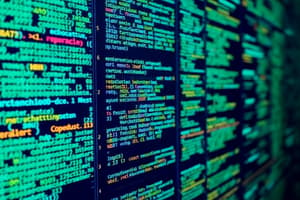Podcast
Questions and Answers
What is the distinction between data and information?
What is the distinction between data and information?
Data are symbols reflecting observations, while information is data that has meaning.
Why is it important for data to be standardized?
Why is it important for data to be standardized?
Data must be standardized to ensure interoperability between different computer systems.
What role do clinical data warehouses play in converting information to knowledge?
What role do clinical data warehouses play in converting information to knowledge?
Clinical data warehouses aggregate data from various sources, facilitating the transformation of medical information into actionable knowledge.
What is the purpose of a Clinical Data Warehouse (CDW)?
What is the purpose of a Clinical Data Warehouse (CDW)?
Signup and view all the answers
Provide an example of a data type and its application in healthcare.
Provide an example of a data type and its application in healthcare.
Signup and view all the answers
What does ICD-type data represent in a CDW context?
What does ICD-type data represent in a CDW context?
Signup and view all the answers
What is the function of natural language processing (NLP) in healthcare?
What is the function of natural language processing (NLP) in healthcare?
Signup and view all the answers
Describe the ETL process used in a CDW.
Describe the ETL process used in a CDW.
Signup and view all the answers
How do computers represent data in binary format?
How do computers represent data in binary format?
Signup and view all the answers
How is the i2b2 platform relevant to clinical data research?
How is the i2b2 platform relevant to clinical data research?
Signup and view all the answers
What is the significance of the ICD-9 code 250.00 in healthcare?
What is the significance of the ICD-9 code 250.00 in healthcare?
Signup and view all the answers
What challenges arise from the lack of meaning in raw data?
What challenges arise from the lack of meaning in raw data?
Signup and view all the answers
What are some tools used for analyzing data in a CDW?
What are some tools used for analyzing data in a CDW?
Signup and view all the answers
What challenges exist in healthcare informatics compared to industries like banking?
What challenges exist in healthcare informatics compared to industries like banking?
Signup and view all the answers
What role do concept extractors play in handling clinical data?
What role do concept extractors play in handling clinical data?
Signup and view all the answers
What information do dimensions in the i2b2 database provide?
What information do dimensions in the i2b2 database provide?
Signup and view all the answers
Signup and view all the answers
Study Notes
Introduction
- Data are symbols or observations reflecting differences in the world. Example: 250.00 (datum is singular)
- Information is data with meaning. Example: ICD-9 code 250.00 means type 2 diabetes.
- Knowledge is information that is justifiably believed to be true. Example: obese patients are more likely to develop type 2 diabetes.
- Computers generate and analyze binary information (zero and one). Each zero or one is a bit. 8 bits is a byte. Bits and bytes have no inherent meaning.
- Bits can occur as various data types, like integers (e.g., 345 or 669988), floating-point numbers (e.g., 14.1 or -1.23), characters (e.g., a or z), or character strings (e.g., "hello" or "goodbye").
- Data can be aggregated into formats like image files (JPG, GIF, PNG), text files, sound files (WAV, MP3), or video files (WMV, MP4). These formats don't define the information within.
- Data is the domain of computer scientists, but information is the domain of informaticians.
- Information retrieval involves both computer science (data) and informatics (information).
Data and Information
- Computer data lacks inherent meaning and needs qualifiers for context and significance (e.g., blood glucose = 127 mg/dL, fasting sample).
- Data must be standardized for interoperability across different computer systems. Otherwise, different computers can't understand each other.
Information to Knowledge
- Clinical data warehouses (CDWs) are used to transform medical information into knowledge.
- Electronic health records (EHRs) are a large source of healthcare data, containing both structured data (e.g., ICD-9 codes) and unstructured text (free text or natural language).
- Interpreting free text needs natural language processing (NLP).
Clinical Data Warehouse
- Data from EHRs, radiology, and pathology are copied into a staging database, cleaned, and loaded into a common database.
- Meta-data describes the data in the CDW (example: ICD-type data).
- Tools like descriptive analytics can be used with data in the CDW to report aggregate data (e.g., number of patients with breast cancer, their age, or menopausal status).
- CDWs do a better job of analyzing and reporting aggregate healthcare data than EHRs, which focus on individual patients.
- CDWs can be used to assess clinical processes, evaluate costs, and analyze possible solutions.
- Informaticians and those working in biomedical research benefit significantly from CDWs.
- CDWs are helpful for tracking infections and identifying trends for public health.
i2b2 Platform
- i2b2 is an open-source, modular system developed at Harvard for integrating biology and bedside medicine.
- It's commonly used by academic institutions in the U.S. for research purposes.
- The i2b2 database structure includes facts (diagnoses, lab results) and dimensions (information which describes the facts) to aggregate data from multiple hospitals.
i2b2 Star Schema
- i2b2 uses a star schema for data organization. This involves dimensions related to patients and encounters, and facts reflecting observation data.
Concept Extraction
- Concept extractors (like cTAKES, MetaMap, or MEDLEE) are used to extract concepts from free text in EHRs or CDWs. These systems vary in their precision, recall, and f-1 score quality.
What Makes Informatics Difficult?
- Compared to other industries (like banking), healthcare data contains subjective factors ("I feel sick") that make it challenging to interpret.
- Healthcare data also contains incomplete, imprecise, and uncertain information, making computational modeling a challenge. In contrast, banking data is more straightforward.
- Human beings can handle this vagueness, but computers have trouble interpreting uncertainty in healthcare data.
HL7 Version 3 RIM Model
- This model provides a standardized representation structure for healthcare data (information systems).
Conclusions
- Computer scientists focus on data; informaticists focus on information.
- There is a gap between healthcare data and information.
- Transforming information into knowledge is a primary aim of informaticists.
- Clinical data warehouses are increasingly important research tools for evaluating healthcare data.
Studying That Suits You
Use AI to generate personalized quizzes and flashcards to suit your learning preferences.
Related Documents
Description
This quiz covers fundamental concepts related to data, information, and knowledge. Understand the distinctions between data types, data formats, and the roles of computer scientists and informaticians. Test your knowledge on how data transforms into meaningful information.




